The Amazing Life of Dr. Peter Gunsolus
(1801-1886)
Researching my ancillary lines, this amazing story caught my attention. Seeking proof of Native American ancestry (long suspected and part and parcel of the Crowson family lore), I found instead an ancestral line filled with the stuff of legends. This is the story of Dr. Peter Gunsolus and his line’s heroics from the time of their migration to Colonial America.
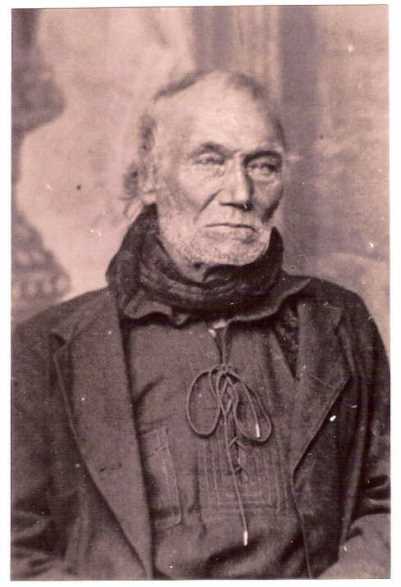
|
December 2, 1874
"Dr. Peter Gunsolus, says a Texas paper, now residing in the neighborhood of Fort Griffin, and who is seventy-six years old, stout, and hearty, who has lived on the frontier the greater portion of his life, informed us that he was now living with his sixth wife; married a young girl each time; has fifty-four children, forty-eight of whom are still alive, and scattered from here to the Pacific, and are doing well."
Early in my research into the life and times of Dr. Peter D. Gunsolus, other historians indicated his family originated in Canada. In my attempt to determine whether or not the Gunsolus family were of the Algonquin or other Canadian Native American tribes, I ultimately discovered quite a different story. From A History of the Kuykendall family since its settlement in Dutch New York in 1646 [Chapter XIV. Cornelius Kuykendaal, his family record, with comments and explanations] comes the following story:
“The marriage of Leur Kuykendall and Lena Consales brought together the Kuykendall and Gunsaulus families, in marriage for the first time. A brief sketch of the Gunsaulus family will now be interesting, and will aid us in understanding the Kuykendall genealogy. While gathering data for this work, as previously stated, there came letters to me from some of our people that mentioned the name Manuel, or Emanuel, as having been borne by some of their forefathers. In reading the “History of Sullivan County, N. Y.” written by Quinlan, we find him quoting from a manuscript history of that county, written by a Lotan Smith, part of which follows:
“About the year 1700 Don Manuel Gonsalus, a Spanish puritan, a young man fled from Spain, on account of persecution for his Protestant sentiments, married into a Dutch family at Rochester, in Ulster county. He moved to Mamakating Hollow, built a log house and entertained those who carried wheat to the Kingston market. Wheat, rye and corn were raised in abundance in Minisink, along the Delaware. Gonsaulus was a house carpenter, made shingles and raised some grain. He opened trade with the Indians, as they were friendly at that period.”
Manuel was a name transmitted for generations in the Gunsaulus family and the name Joseph, also. The tavern and mill of the Gunsaulus people were the first in Sullivan county. Here in Mamakating the family lived for many years. The first mention of the name in the Kingston church records was Nov. 16, 1694, when Manuel Gonsales and Marritje Davids had their son Manuel baptized. This is probably the Manuel that is buried about two miles above Wurtsborough, N. Y. Daniel [MEC NOTE: believe this should be Manuel?] was captured by the Indians, when a child, and carried off by them, and adopted by the wife of an Indian chief. But he succeeded afterwards in escaping and returning home. His wife was Elizabeth Kuykendall, of Mamakating, a woman of abundant courage and sufficient physical ability to back it up…There were, in early days three Manuels Gunsaulus at Mamakating, supposed to be grandfather, father and son. They had lived at Kingston, before moving to Mamakating, and must have known the Kuykendall family there. This same branch of the Gunsaulus family were the ancestors of Ref. Frank W. Gunsaulus, of the Armour Institute.”
This branch of the Gunsolus (with many, many variations of spelling through the years) is rife with stories of dramatic and unusual experiences. Various family members have been commemorated from time to time for the courageous undertakings and for some tragic fates. It is now commonly believed this particular family descends from one man, known as the Immigrant Gaunsalus forefather:
The Consalus family of Troy descend from a Spanish Heugonot ancestor, Don Manuel Gonzales who is believed to be the first permanent white settler of Sullivan County. He had sons who perpetuated his name. Don Manuel is said to have come from Holland in his own ship. [SOURCE: “The Consalus Family in New York”]
After migrating from Holland to the shores of the Americas, Don Manuel wed into a prominent Dutch family. The Spanish Huguenot and his line would intermingle with various Dutch emigres through the following years, both immigrant families leaving their indelible marks of courage, perseverance, diligence, industry, and loyalty upon the new lands.
It is quite possible that our Peter D. Gunsalus was the child of a Native American mother rather than one of the daughters of the stern and strict Protestant Dutch families, for no marriage is recorded, nor has history provided any name other than “a local maiden” as the woman who bore the child of 17-year-old Emanuel Gonsalus Duk before his marriage at age 20 to Christina VanAlstyne, a most acceptable Dutch daughter. At that point in time, the relationship of white settlers was still friendly with the local Indians. This is not, however, a fact made viable by any supporting documentation and is merely the musings of your author.
The Gonsales (however spelled) family certainly left its mark on the frontier of New York in Colonial America. Their time was not, however, to be lived in complete peace and prosperity. There is a harrowing tale of savage attack by marauding Indians, Hell bent on revenge, apparently, that – quite literally – tore the Gonsalus family’s core group into shreds and scattered the survivors to new locations of safety. The following story concerns two generations of this family, whose lives became embroiled in the conflicts surrounding the run-up to the Revolutionary War:
Joseph, son of Emmanuel Gonzales, married Margaret Dutcher, of Dutchess County, NY, who was a direct descendant in the forth generation of Anneke Jansen of Trinity Church litigation fame. Joseph had taken up his abode in the extreme southwestern corner of Saratoga, County, in what is now known as the town of Charlton. Previous to the revolution, he had lived on the friendliest terms with the Indians. On the breaking out of the war, however, the Gonzales family, almost the only one in that sparsely settled section that had openly espoused the cause of the colonists, became objects of especial hate to the Tories, particularly to the Scotch residents of Charlton who generally were on the side of the King. The family of the daring pioneer Joseph, consisted of his wife and four sons; Emmanuel, the oldest, was a man of great strength and had frequently bested the Indians, which further incited the hostility of the Indians and Tories. In April 1782, a party of St. Regis Indians who were returning from their winter hunting and fishing in the Adirondacks, came nearly a hundred miles south to destroy the Gonzales family before returning to Canada. Whether they were prompted by the Tory element, or to avenge their rough handling by young Gonzales has never been ascertained. Joseph, the father, with the farm hand, the eldest and two youngest sons were turning a summer fallow in the field, while the mother, daughter, and second son, David, were at the house. As the Indians came up, Joseph extended his hand in friendly salutation. The Indian responded with a blow from his tomahawk which killed him instantly. At the same time the Indians seized the hired man and the two sons, Emmanuel, by main strength broke away and headed for the nearby woods. As he was scaling the first fence he was again seized but again broke away although he was shot through the hand. As he leaped the last fence that separated him from the woods, he received a shot that killed him instantly. Joseph, the youngest son, age twelve, succeeded in reaching the house in the meantime, and David at once put his mother, sister, and brother in a wagon and escaped to Crane’s village, three miles away. This David went west and is the progenitor of those of that name, among whom is Reverend Frank Gunsaulus of Chicago, Illinois.
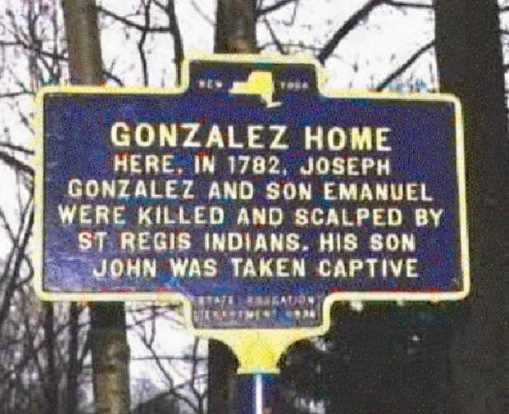
Historical Marker in Saratoga County near Charlton, New York, ommemorates story about the scalping and kidnapping of early Gunsolus' family members
The Indians scalped Joseph and Emmanuel, placed their scalps on a pole and taking John and the hired man, started on the long march to Canada. The sufferings of the trip cannot be told but they finally reached the capitol of the St. Regis Nation where John had his face painted and his head shaved and was compelled to carry the scalps of his father and brother through the camp. This massacre broke up the Gonzales family. Rebecca, the eldest daughter, had previously married Emmanuel De Graff, of New Amsterdam. The mother and younger children removed to Schenectady, where the mother died soon after, heartbroken over the fate of her son John. A Granddaughter of David married Commander Constable, of the United States Navy. The history of John continues in the next generation.
(IV) John, Son of Joseph and Margaret Dutcher Gonzales, was a lad of 15 when forced to take the terrible march to Canada. He was compelled to “run the gauntlet” and forced into the British service, but he bore all the trials with true Yankee fortitude. He was employed in making cartridges, but he mixed the powder with charcoal saying: “None of these will ever harm my countrymen.” Although peace was declared about a year after his capture, he was kept in captivity two years longer, obtaining his release in 1785. He had become a favorite with some of the British officers, who offered him land in Canada if he would remain. He was eighteen at the time and pluckily replied: “All the land I want from you is enough to walk on until I get off it.” He returned to the Mohawk valley and the first relative he found was Mrs De Graff, whose descendants yet reside on a farm near Amsterdam. His father, whose tragic fate we have related, had previous to his death contracted for 1500 acres of land in Saratoga, but through his death the estate was lost. John however, on attaining his majority, bought a portion of the land a mile northwest of West Charlton, on which he and his descendants have since resided. He built the first frame dwelling in the southwestern part of the county and improved his land, bringing it to a fair condition of productiveness. In 1791 he married Dorcas Hogan of Albany who bore him twelve children, dying October 7, 1823. The change of name occurred in this generation. On the rolls of the British, kept while he was their prisoner, his name was written Consalus, and that orthographic has been retained by his descendants. [SOURCE: This story taken from a book of the history of the Hudson and Mohawk Valleys in the State of New York, pages 680, 681, and 682. THE CONSALUS FAMILY IN NEW YORK
Thus, it appears, we have the source for the legend that the Gonsalus family came to New York in Colonial America from Canada.
It is not surprising, given the history of this determined, intelligent, and prolific family that our subject, Dr. Peter D. Gunsolus, would have lived his life by forging his own dramatic history as he ventured from his origins in New York state to his final resting place in Breckenridge, Texas. It has oft been related that Peter Gunsolus moved into each new frontier of the emerging American continent, living in each and every territory of each state ultimately forming a part of the United States BEFORE the domestication of that land was complete!
Peter D. Gunsolus was born 10 Mar 1801 in the wilderness of New York. Without a proper Baptismal date, we are left to surmise whether he was born in Mamakating, (later Ulster County), New York where the father was enumerated in the 1790 census, or after his father moved to Broadalbin, Perth County, New York, before taking Christina VanAlstyne as his wife in Prince Edward Island, Canada in 1803. His father was Emanuel Gunsalus Duk, born 3 May 1783 in Albany, New York and died 12 Jan 1846 in Wheeler, Stuben County, New York. As mentioned above, no name has been supplied for his mother other than “a local maiden” leaving one to imagine that heritage.
Peter Gonsalus’ grandfather was Johannes Gunsolus, born 16 May 1742 in either New York or Connecticut (depending upon which history you wish to accept), and died 6 Dec 1801 in Broadalbin, Perth County, New York.
The first record found for Peter is the 7 Aug 1820 US Federal Census for Lawsville, Susquehanna, Pennsylvania, in a household enumerating one male aged 26 to 44 (does not equate with believed birthdate for our Peter), a female aged 16 to 25, and one free white female under the age of 10, a total of three persons total.
A marriage is then noted for Peter with one Elizabeth “Eliza” Gunsalus, maiden name not known, and only referenced with the US Federal Census of 1830 for Lawsville, Susquehanna, Pennsylvania. This household enumeration more closely tracks the believed age of Peter: One male aged 30 to 39 (he was 29?), 2 little girls not yet 5, one girl between 5 and 9, and an adult female aged 30 to 39. Total in household: 5.
By April of 1835, Peter has moved on. He purchases 160 acres in LaSalle County, Illinois, and completes the purchase, apparently, two months later.
In 1838, he has “moved on” in another area of his life: he now adds another wife, named Susannah Lynn (some say Voin – although a later wife bore that maiden name and your author believes these two women’s histories may have been conflated).
By 1840, the US Federal Census enumerates Peter’s household in Macon, Missouri. The little household now is home to four: one little boy under 5, an adult male aged (?) 20 to 29 (Peter is now 39?), one girl aged 10 to 14, and an adult female aged 20 to 29. Only Peter is engaged in agriculture.
In 1848, Susannah Lynn Gunsolus passes away. By 18 Nov 1849, Peter has taken a new wife, Margaret Jones Davis. They are wed in Liberty, Clay County, Missouri, (a well known location for our research for our paternal line.)
In the US Federal Census for 1850, researchers are treated – for the first time – to actual names, ages, and relation to head of household for all household members. Still a resident of Liberty, Clay County, Missouri, Peter’s household is enumerated thusly: Peter Gunsoles 41, Margarett Gunsoles 30, Eliza Gunsoles 18, James Gunsoles 12, Mary J Gunsoles 10, Fanny J Gunsoles 8, Jas Gunsoles 6, Peter Gunsoles 4, Polly A Davis 15, Matilda Davis 13, and Clarinda Davis 11. These three girls are assumed to be stepdaughters to Peter, children borne by new wife Margaret Jones Davis during her prior marriage.
1851 finds Peter a widower yet again. Margaret Jones Davis Gunsolus has gone to meet her maker. But, Peter needs must have a mother for all those little children, so we find a marriage to Nancy Jane Stevens on 15 Jan of 1852, said marriage taking place in Clay County, Missouri. One researcher deems this wife to be Peter’s sixth. Somehow, your author must have missed two marriages if this is true, not surprising considering the dearth of records in frontier towns, the constant mobility of our subject, and the frequent misspellings that cause vital records to be overlooked.
Although records show Nancy Jane Stevens Gunsolus to have lived until 1859, Peter has taken another wife before that time. On 31 Jul 1853, Peter marries one Susannah “Susan” Voin Jones in Laclede, Missouri. This will be his final marriage, records showing Susannah to be a constant in his remaining years. Peter is now 52 years of age. He has moved constantly from one side of the continent to the heart of the country yet being formed. A chance decision will now become a turning point in his life. As related in the newspaper report of the death of one of Peter’s daughters, one Frances “Fannie” Jane Gunsolus Lynch, (daughter of the first wife named Susannah Lynn):
It was down on the Rio Grande, back in the California gold rush days, that Fannie J. Gunsolus, 15-year-old daughter of a Missouri doctor, en route west in search of wealth and gold, met a handsome, six-foot stranger, J. C. Lynch, returning from the Pacific coast, his wanderlust satisfied. Six months later the two were married somewhere along the river border in what is now New Mexico.
Young Lynch an Irish imigrant had been in Texas and yearned for the "knee high grass country,” the range and the saddle, and the next year after the meeting, he persuaded the Gunsolus family to accompany him and his bride to the Lone Star state.
The Gunsolus family settled in Stephens county, near where Breckenridge now stands and Gunsolus Creek, running near that city, was named for the British (*) doctor.
The young Lynch couple moved into Shackelford county with a herd of cattle…and settled on Elm Creek. A dugout was their first home, and they received $15 a month and board. Later they acquired 160 acres of land at 25 cents an acre. They built a shack and started an accumulation of cattle and land that soon placed them in the forefront as ranch people in this section. More than 30,000 cattle, carrying a Lynch brand, at one time roamed the 10,000 acres of Lynch land. Thirteen years after they set up housekeeping in a dugout, they built a stone ranchhouse, now occupied by J. D. Lynch, a son and his family. There, Mrs. Fannie Lynch retained a suite of rooms, and when she was not visiting with children or grandchildren she lived in the home for which she selected the spot marked on a lone liveoak sapling nearly 50 years ago. [SOURCE: Abilene Morning News, published Tuesday Morning, January 20, 1931] (*) Dr. Gunsolus was not British
By 1870, the US Federal Census, shows Peter and his household at Lynch’s Ranch, Stephens County, Texas, the household members as shown: Peter Gunsolus, 66, Susana Gunsolus 35, Wm Preston Gunsolus 13, John Alexander Gunsolus 11, Sarah Irva Gunsolus 8, Soloman Gunsolus 6, Patsy Ann Gunsolus 4, Alex Brons 9 and Frances Brons 7. Your author has no idea how the Brons children fit in to the home.
In 1880, Peter is enumerated again, this time in Precinct 4, Stephens County, Texas, with the household members: Peter Gunsolus 77, Susanah Gunsolus 47, Patsy Gunsolus 14, and Solomon Gunsolus 16.
The following was contributed by a family researcher, concerning this remarkable man:
The attached article is from the "Albany Star" (a newspaper in Albany Texas) dated July 26, 1883...."Old Dr. Gunsolus, the oldest citizen in Northwest Texas (West of the Brazos River) was in town this week looking hale and hardy. The doctor was photographed at Burnett's Gallery and the picture to be sent to Harper's Weekly by Dr. W. I. Baird. Dr. Gunsolus is the father of 57 children and is married to his 6th wife."His 6th wife was Susannah Voin Jones Gunsolus, my great great grandmother...Earlene Humphries 4/2008
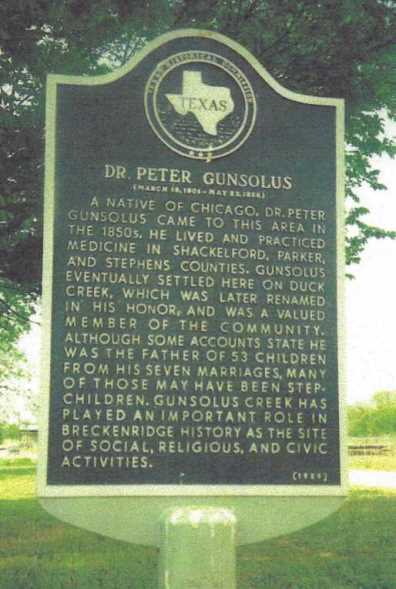 |
| The Marker is in Breckenridge, Texas. |
On 23 May 1886, Dr. Peter D. Gunsolus is noted deceased at Brushy Creek, Williamson County, Texas, with his remains interred at the Lynch Cemetery in Shackelford County, Texas. The obituary for this amazing man read as follows:
Dr. Peter Gunsolus, one of the oldest pioneers in this section, died at his residence on Brushy creek, Stephens County, Saturday night and was buried Sunday evening at the private burying grounds of his son-in-law, J. C. Lynch, in this county. He was eighty-six years old and has lived on the frontier of every territory that has become a state since Illinois was admitted in 1818. He was at one time a scout under Gen. Kerney.
The Abilene Morning News carried news of the last surviving offspring of Dr. Peter D. Gunsolus:
Abilene Morning News (Abilene, Texas) - Abilene, Texas, July 5, 1935
JNO. GUNSOLUS OF BRECK. DIES
Indian Fighter, 83, was son of founder of Old Picketville
Word was received here Thursday of the death of John Gonsulus, last surviving offspring of Dr. Peter Gonsulus who was founder and physician of old Picketville, forerunner of Breckenridge. He died yesterday at 4 a.m. at the family home in Stephens County.
His father, a lusty French-Canadian, was famous as the husband of seven wives and father of 42 children. Before moving his large family to Texas, the pioneer’s father had a frontier store on 150 acres on the site of present-day Chicago.
Gonsulus is survived by his wife, one son, two grandchildren, and two great-grandchildren. He was a great-uncle of C. O. Lynch, employee of the Abilene Reporter-News.
Burial will be this afternoon at 4 o’clock on the Lynch ranch east of Albany beside the graves of his father and mother.
He was born in 1852 in a cabin on the banks of the Stephens county stream named for his father. Gunsolus has recalled having seen or having participated in 12 Indian fights, early day stampedes, the pony express days and having made 20 trips up the Longhorn trail.
At least one researcher attempted to pin down the actual number of wives and sired offspring to be accurately attributed to Dr. Peter D. Gunsolus. The list provided (with no attribution for the shared post) is as follows:
1. Eliza Gunsolus b: 1832 in New York
2. James (J. T. ) Gunsolus b: 1838 in Illinois (married Martha Ann Vanhooser)
3. Mary Jane Gunsolus b: 1840 in Missouri
4. Fannie Gunsolus-Lynch b: December 25, 1843 in Missouri. (married John Cornelius (J.C.) Lynch)
5. Isaiah Gunsolus b: October 26, 1844 in Missouri (married Icey Binda Ramsey)
6. Peter Gunsolus (II) b: 1846 in Missouri (married Lockney Jane Vanhooser
7. William Preston Gunsolus b: 1857 in Texas
8. John Alexander Gunsolus b: January 07, 1859 in Texas d: July 04, 1935 (married Mary Ann McNutt)
9. Sarah Ann Gunsolus b: 1862 d: March 21, 1886 in Texas (married Albert Samuel Sanford Swan)
10. Solomon Gunsolus b: 1864 d: 1885 (married Susan Pyles)
11. Patsy Ann Gunsolus b: 1866 in Tx (married Joseph Mitchell Pyles)
There were actually about 17 children sired, not all who carry his name are his seed, but rather adopted by him as he married. Some wives were widowed and some were abandoned and some were divorced. And all but the first wife and wife Jane, came with children of a different marriage. The practice of marriage for sake of convenience brought provision for their seed. They needed a Mother and a Father. It was too hard for either with children. However, If Peter D got tired of the marriage, he would leave and take the kids with him. Whether he paid off the spouse for the children remains speculation. But he claimed them all as his own.
It is certainly worthwhile to relate the following history provided by a dearly beloved member of the Crowson family, descended from Dr. Peter D. Gunsolus:
Dr. Peter D. Gunsolus is thought to have been born in New York around 1801, a member of the Gonsolus clan that originially migrated from Spain to the Nevertherlands and then as a part of the Dutch settlement of the New York area (New Amsterdam) of early Colonies. We are unsure exactly who Peter's father was but oral history indicates his mother was American Indian, possibly Iroquois.
We know he moved to the Chicago area early on in his life. In this area we think he participated in the "Black Hawk Indian War" and is thought to have received medical training, possibly at Rush Medical College in Chicago to compliment the herbal medicene training he supposedly acquired through his mother's people. There are records that he received land as compensation for his service in the wars to settle this area. Peter left the Chicago area moving south into Missouri in about 1840. Peter was married at least four times and had a large number of children beginning in 1832 in New York. Peter married his last wife and my great-great grandmother Susannah Voin Jones in Missouri in 1853.
Peter must have had an adventurous spirit as he only settled down after he had reached an age well after what most people consider "old" in the 1850's. Peter and Susannah after having several children in Missouri headed west to California. They made it as far as the Santa Fe, New Mexico Territory where a problem developed with the guides that were leading them west. A disagreement between one of the guides and a young Irishman, John C. Lynch led to a fist fight and parting of the ways with the wagon train west. John Lynch fell in love with Peter Gunsolus' daughter, Fannie Jane and they were married somewhere near Santa Fe. John Lynch convinced Peter that Texas had the promise they were looking for and they traveled back to the area of Texas west of the Brazos now known as Jack, Stephen, Parker and Shackleford counties (but at that time the heart of Comanche Indian country). They settled near a clear running, rocky creek called Rock Creek in Parker County.
This part of Texas was dangerous country with only nearby Ft Griffith (near Albany) and Ft. Richardson (Jacksboro) considered "partly civilized" This was the edge of the great Texas frontier and many noted buffalo hunters and badmen spent time at these forts, Wyatt Earp, Bat Masterson and Wild Bill Hickok to name a few.
Peter was recognized as one of the first doctors west of the Brazos River and was noted as "Dr. Peter Gunsolus" in several publications in the 1860's and in the 1870 census he listed his occupation as "Physician". Life on the Texas frontier in the 1860 to the 1880's was hard and dangerous. Peter lost a son and grandson to Comanche raids in 1867 (notes from "Indian Papers of Texas").
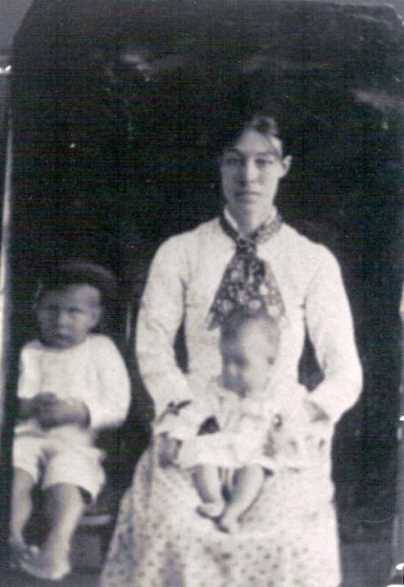
Sarah Ann Gunsolus Swan holding Fannie Olivia Swan 1883
My great grandmother, Sarah Ann Gunsolus who married Albert Swan, was the oldest daughter of Peter and Susannah, . She died at the age of 24 when my grandmother was only 3 years old. My grandmother, Fannie Olivia (Ollie) Swan was named after her mother's half-sister, Fannie Gunsolus Lynch. Fannie Olivia Swan married my grandfather, John Goodwin Crowson.
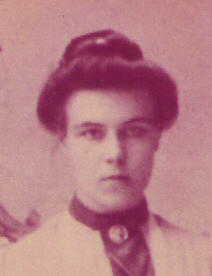
Fannie Olivia Swan (Crowson) - mother of Johnie Randle Crowson - (Bobbie's Daddy, David and Earl's grandfather)
My father, William Earl Crowson who recently passed away at age 83, remembered visiting his Gunsolus relatives and knew Peter's son, John Gunsolus who was a noted indian fighter from the early Texas frontier days. My dad played in the clear running "Gunsolus Creek" as a youngster and this creek served as the main water suppy for many years for the town of Breckenridge Texas.
Leona Earlene Crowson Nov 2008
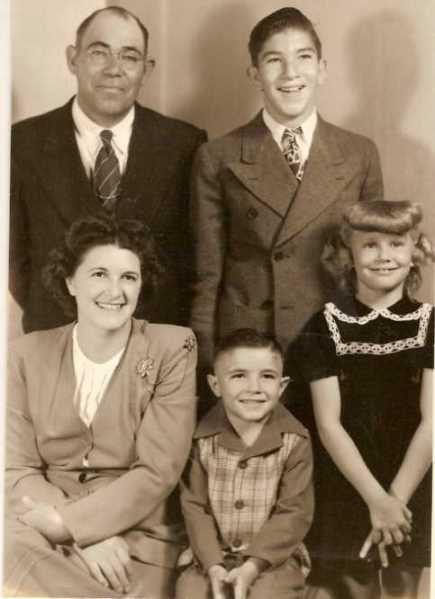
|
Grandpa Johnnie R. Crowson with Lila, Bobbie, Dorothy and Ronnie






No comments:
Post a Comment